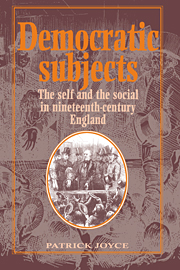Book contents
- Frontmatter
- Contents
- List of plates
- Acknowledgements
- Introduction
- Part One The sorrows of Edwin Waugh: a study in ‘working-class’ identity
- Part Two John Bright and the English people: a study in ‘middle-class’ identity
- 7 Plain man's prophecy
- 8 Speaking Bright
- 9 Making the self
- 10 Bright makes the social
- 11 Creating the democratic imaginary
- Part Three Democratic romances: narrative as collective identity in nineteenth-century England
- Appendices
- Index
10 - Bright makes the social
Published online by Cambridge University Press: 10 December 2009
- Frontmatter
- Contents
- List of plates
- Acknowledgements
- Introduction
- Part One The sorrows of Edwin Waugh: a study in ‘working-class’ identity
- Part Two John Bright and the English people: a study in ‘middle-class’ identity
- 7 Plain man's prophecy
- 8 Speaking Bright
- 9 Making the self
- 10 Bright makes the social
- 11 Creating the democratic imaginary
- Part Three Democratic romances: narrative as collective identity in nineteenth-century England
- Appendices
- Index
Summary
We can talk of a self made; we can also talk of a self deployed in the public realm (from whence it is returned to the subject in a new form). Bright deployed himself, and was in turn deployed by his contemporaries. What models or conceptions of the social order can we see Bright himself deploying? Perhaps the most revealing one is a vision of independence that was almost the exact social analogue of the personal self. The created self of the common, plain man issued in a social utopia of the plain man. The understanding of his father's condition as of the common people produced a social vision in which the imagined society of the patriarch was reproduced in an imagined social ideal, that of what might be termed the urban yeomanry. This social vision had no fixed social base or constituency: it could and did appeal to men of many social conditions and ‘classes’, not least men of the ‘working class’ for whom a vision of social, moral, and political independence was of quite crucial significance.
When men of the ‘middle class’ spoke of what it was to be middle class, especially in the first half of the century, this dimension of independence was central to the meanings given these words.
- Type
- Chapter
- Information
- Democratic SubjectsThe Self and the Social in Nineteenth-Century England, pp. 124 - 135Publisher: Cambridge University PressPrint publication year: 1994



